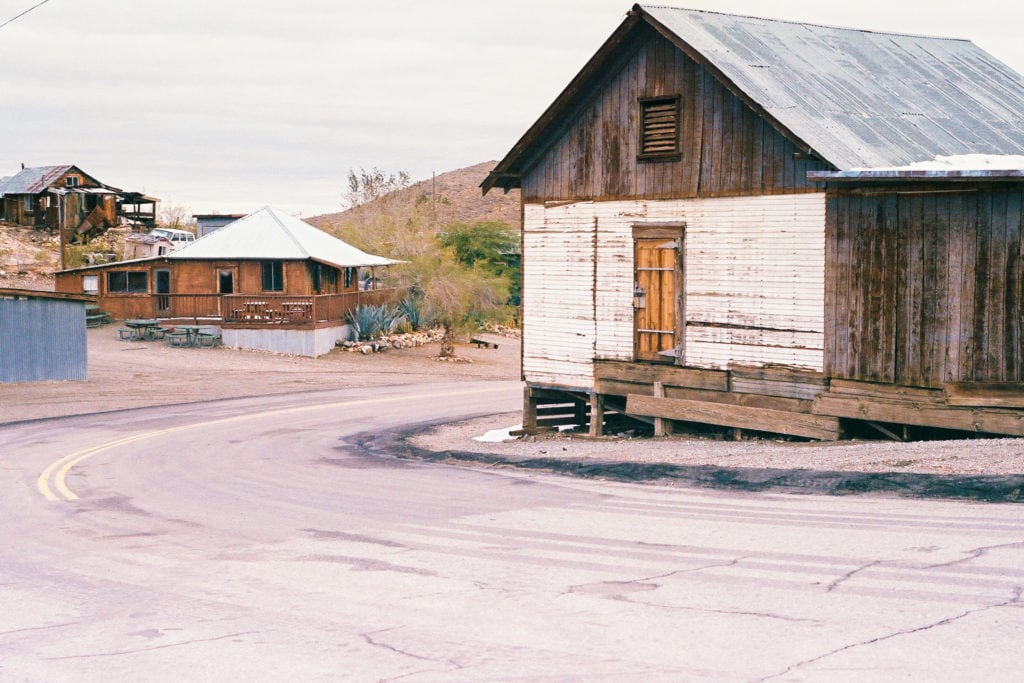As a Sunday in early December comes to a close in Randsburg, California, the sounds of dirt bikes and car horns reverberate across the otherwise silent town. It’s the first of the month and the last day of the busiest time of the year, when the population of Randsburg—a tiny town resembling a Western movie set, located on the edge of Kern County—swells from less than a hundred residents to several thousands.
I drive to Randsburg in the morning to catch the tail end of the surge that usually begins the day after Thanksgiving—and to admire the snow that has just covered the Mojave desert. An antique shop employee says this is the first time that she’s seen snow on Thanksgiving Day in Randsburg.
Once a booming gold rush town, ancient mining equipment is scattered across Randsburg, but most of the gold is long gone. It looks and feels as if one day almost everyone decided to pick up and leave town at the same time. You won’t find a chain restaurant or bank for more than 20 miles. But Butte Avenue, the main vein of Randsburg, still features a row of tin-roofed businesses: a 19th-century general store, a few bars and antique shops, and one hot rod garage.
Across the street from one of the antique shops is the oldest business in town: The Joint, a family-owned bar and the undeniable heart and soul of Randsburg. When I step inside, Neil Shotwell, the bar’s third-generation owner, greets me with a firm handshake and smile. “Welcome home, brother,” he says.


Middle of nowhere
In 1955, Shotwell’s entrepreneurial grandmother, Olga Angelina Rizzardini Shotwell Guyett, and her husband took over The Joint. “She never cursed, she never drank, she never smoked,” Shotwell says. The interior still features portraits and news clippings of Olga, alongside neon signs, and dollar bills with signatures scribbled on them. A machete hangs next to the front entrance, a rifle sits above the cash register, and there are plenty of vinyl couches, booths, and chairs into which visitors can disappear—and forget for a moment that they’re in the proverbial middle of nowhere.
By noon, the dirt parking lot outside of The Joint is full of dirt bikes and dune buggies. Riders caked in mud shuffle into the bar to take a break and toss back a few drinks. I meet a man who is in town to mine gold for a few weeks. The woman from the antique shop across the street comes over and orders a hot chocolate. Another local stops by with a container full of homemade pork ribs. By the end of the day, another regular offers to let me stay in their RV the next time I’m in town.
The snow keeps some people away, but not enough to call The Joint “quiet.” The night before, a Saturday, was “like a zoo,” Shotwell says. Not only was The Joint packed with people, a couple of horses made it inside the bar as well (but luckily they didn’t make too much of a mess). The surge in business is welcomed in Randsburg—for some, it keeps them in business for the rest of the year.

Cause for concern
On a busy weekend it might be hard to imagine, but in December 2019—before the first COVID-19 cases were identified in the U.S., and before restaurants and bars across the country were forced to close their doors—The Joint was already struggling.
Six months before my visit, on July 4, a 6.4-magnitude earthquake hit the area surrounding Randsburg. According to seismologist Dr. Lucy Jones, there have been more than 40,000 quakes in the Ridgecrest area since. Shotwell says that he has felt hundreds of them while working at The Joint.
But natural disasters aren’t his only cause for concern. As the day winds down, the last few remaining riders in the area sprint up and down Butte Avenue on dirt bikes, popping wheelies. Shotwell films them as a cigarette dangles from the corner of his mouth. He’s smiling, but urges the riders to be cautious. He says he’s seen innocent fun turn to tragedy numerous times during his time spent behind the bar. About 30 miles away, there’s a memorial dedicated to people who have lost their lives riding motorcycles in the Mojave and elsewhere.
“At least nobody died this weekend,” Shotwell says.





At the end of 2019, Shotwell was already anticipating having to fix the bar’s old tin roof and had concerns about his ability to keep the 115-year-old building up to code. But he was also looking forward to 2020 and celebrating The Joint’s 55th birthday.
Prosperous but infamous
Founded as a tent city in 1896, at its height, Randsburg was a prosperous but infamous mining town. Gold was discovered on the slope of Rand Mountain in 1895, and by 1899, the town had more than 3,500 residents. Several fires around the turn of the century decimated the original town, but the building that houses The Joint has stood since 1905. More recently, Randsburg has been featured as a location in several Hollywood films and commercials.
The Joint was closed for six weeks earlier this year due to COVID-19. In mid-June, Shotwell was given the green light to resume service, but less than three weeks later, California Governor Gavin Newsom ordered 19 counties—including Kern—to once again shut down bars and dine-in service.


For more than half a century, the Joint has been a lifeline to Randsburg, a town that has survived through several boom and bust periods. Despite fires, earthquakes, and smallpox and influenza epidemics, Randsburg has found a way to persevere. But the future of The Joint—and one of the last remaining living ghost towns along the California Gold trail—remains uncertain.






